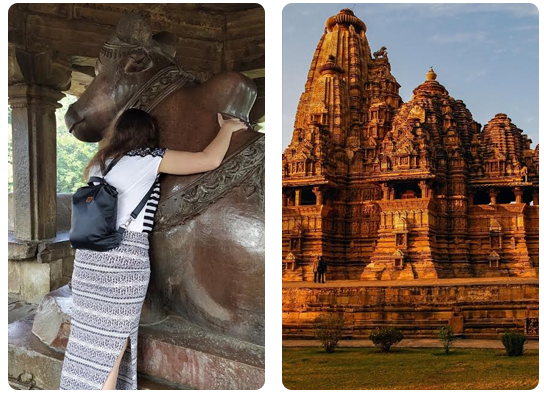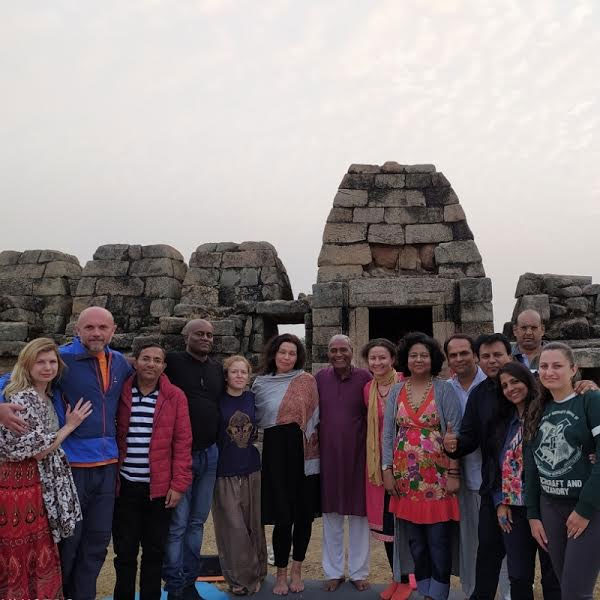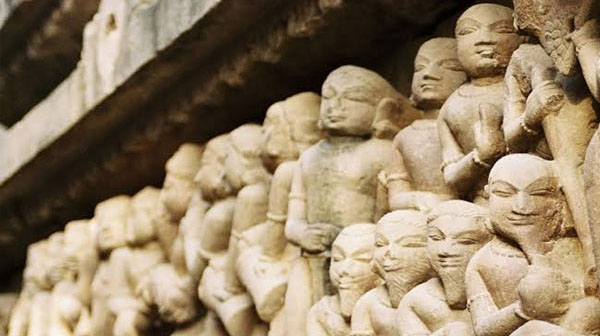Dates
05– 11 December, 2022
Scared temples of Khajuraho which is the gem rooted in heart and soul of tantra, beautifully sculptured attracting thousands of people across the world.
Khajuraho, the land of kama (love) where one can experience the divine cosmic energy of eternal love. Tantra is the spiritual practice to expand consciousness and joining male and female energy as whole transforming sexual energy into spiritual energy.

05– 11 December, 2022

On Request

Khajuraho

Accommodation
Vegetarian meals
Tea/Coffee
Free Pickup from Airport
| Time Table | 05th Dec Monday |
06th Dec Tuesday |
07th Dec Wednesday |
08th Dec Thursday |
09th Dec Friday |
10th Dec Saturday |
11th Dec Sunday |
|---|---|---|---|---|---|---|---|
| 7 AM - 8 AM | Welcome ceremony/ Reception |
Dynamic Meditation | Dynamic Meditation | Dynamic Meditation | Dynamic Meditation | Dynamic Meditation | |
| 8:30 AM - 9 :30AM | Organic Breakfast | Organic Breakfast | Organic Breakfast | Organic Breakfast | Organic Breakfast | Organic Breakfast | |
| 10:00 AM - 10:45 AM | Group Dancing / Gathering / Singing / Sharing | Departure |
|||||
| 11:00 AM - 2:00 AM | Tantra Morning Workshop 1 | Tantra Morning Workshop 2 | Tantra Morning Workshop 3 | Tantra Morning Workshop 4 | Tantra Morning Workshop 5 | ||
| 2:00 AM - 3:00 PM | Lunch | Lunch | Lunch | Lunch | Lunch | ||
| 3:00 AM - 4:00 PM | Leisure / Free Time | Leisure / Free Time | Leisure / Free Time | Leisure / Free Time | Leisure / Free Time | ||
| 4:00 PM - 5:30 PM | Opening Ceremony |
Tantra Evening Workshop 1 | Tantra Evening Workshop 2 | Tantra Evening Workshop 3 | Tantra Evening Workshop 4 | Tantra Evening Workshop 5 | |
| 7:30 PM - 8:30 PM | Dinner | Dinner | Dinner | Dinner | Dinner | ||
| 9:00 PM - 10:00 PM | Indian Classical Music | Indian Classical Music | Tantra Music | Tibetean Sound Healing | Tantra Dancing / Closing Ceremony | ||
| 10:00 PM - 12:00 AM | Night Meditation/ Love Temple |
Night Meditation/ Love Temple |
Night Meditation/ Love Temple |
Night Meditation/ Love Temple |
Night Meditation/ Love Temple |
||
The land of kama and the birthplace of tantra Khajuraho Is known for its beautifully carved erotic sculptures attracting thousands of people across the globe.
Khajuraho group of Temples are the religious Temple dedicated to two religions Hinduism and Jainisml ocated in Chhatarpur district, Madhya Pradesh.
Khajuraho group of monuments got recognized as a UNESCO world heritage sitein 1986.
Khajuraho is the splendid saga of erotic and sensual sculptures, bringing ecstasy into stones. For thousands of years, these Temples are living examples of Indian fine art and culture. It is the top heritage site in the country Built in a scientific way, supporting evolution by using tantric methods.
Khajuraho, one of the birthplaces of tantra with most erotic and sensuous sculptures the world has known is carved on the temple walls of Khajuraho, Madhya Pradesh.
Khajuraho sculptures and art forms demonstrate the pinnacle of temple architecture developed by chandella dynasty thousands of years ago.
Recognized as a UNESCO world heritage site. Khajuraho group has many temples that follow the design of Nagra-stye architecture made out of granites and sandstones.
It’s interesting to note that theKhajuraho group of temples were dedicated to two religions, Hinduism and Jainism.
There are three groups in the Khajuraho group temples namely Eastern, western and southern.
The eastern group is mostly dedicated to Jainism comprises of carved Jain temples. Western and southern groups are mostly inclined to Hinduism which is dedicated to Hindu gods and goddesses.
The Eastern group of temples
Brahma temple, Vamana temple, Ghantai temple, Paraswanatha Jain temple.
The Western group of temples
Chausathjogini temple, Kandariya Mahadeva temple, Devi Jagdamba Temple, Vishwanath Temple.
The Southern group of temples
Duladeo Temple, Jatkari Temple

Khajuraho represents a unique artistic creation of erotic art form that signifies Dharma, Kama, Artha and sexual procreation which is an essential aspect of human life. Core belief revolves around four tenets of Hinduism: karma, dharma, moksha and kama (values, righteousness, liberation and pleasure) respectively. Khajuraho sculptures and art form demonstrates the erotic tantric mysteries carved in stones. These sculptures symbolize Purushartha four aims of human life: karma, dharma, moksha and kama (values, righteousness, liberation and pleasure) respectively.
There are three groups in the Khajuraho group Temples namely Eastern, western and southern.
The eastern group is mostly dedicated to Jainism comprised of carved Jain Temples. Western and southern groups are mostly inclined to Hinduism which is dedicated to Hindu gods and goddesses.
| Brahma Temple | Located on the shores of Khajuraho Sagar, it is believed that the image of the four faces (chaturmukha)is of lord shiva. It is believed that the Temple was constructed about the last half of the 9th or first half of the 10th century. |
| Vamana Temple | Located on the northeast side of the Brahma Temple, this temple is 63 meters long and 46 meters wide and stands on a very high point. It also has a portrait of Vishnu's body engraved on the frame and a statue of King Brahma in a touching bhumisparsa-mudra. |
| GhantaiTemple | The temple is named after the chains that hang on the chains that adorn the pillars of its porch. Above the temple, entrance stands a statue of eight armed Jaina Goddess mounted on Garuda and armed with various weapons. Each end of the arch has a statue of Tirthankara. |
| Paraswanatha Jain Temple | It is the largest templeof Jain, which is 69 feet long and 35 feet wide. It is believed to be the sanctuary of Parsawanatha. |
| ChausathjoginiTemple | The Temple courtyard contains 64 small cells corresponding to the number of Yoginis, the female helpers of the goddess Kali, after whom the Temple is named.The Temple is located on the main roof and has a courtyard 104 feet long and 60 feet wide. |
| Kandariya Mahadeva Temple | It is the largest of the Temples of Khajuraho built in 10th century that is 109 meters high and 60 meters wide. The interior design of the Temple is different from the typical Hindu Temple. The female figures below the bandits are identified as Goddess Ganga (River Ganga) and Goddess Jumna (River Yamuna). |
| Devi JagdambaTemple | The Temple is now known as Devi Jagdamba or the ‘Mother Goddess of the Earth’. It was originally believed to have been given to Lord Vishnu as his figure is in the form of a sanctum door. It also has the numbers of Lord Shiva and Lord Brahma on the right and left. According to some inscriptions found here, it is thought that the Temple was built around the eleventh century, a time when the Candela dynasty ruled. |
| Vishwanath Temple | Vishwanath 'lord of the Universe', is another name for Lord Shiva dedicated to this Temple. At a height of 90 meters, the entrance to the sanctum sanctorum features a statue of King Shiva sitting on Nandi.According to the inscription, the Temple was built under the watchful eye of King Dhanga who dedicated it to King Shiva by attaching a Wall with emerald embedded inside it. |
| Duladeo Temple | Another famous Temple half-mile away from the main Khajuraho Temples dedicated to sivacult. It was constructed around 10th century measuring a height of 70 feet and 41 feet wide. |
| JatkariTemple | A west facing temple situated near jatkari village dedicated to Lord Vishnu in form of chaturbhuja (four armed). |
The name Khajuraho is derived from the Sanskrit word khajur which means date palms. Inscriptions from the Temples of Khajuraho show that these shrines were built from 950 to 1050 AD. The construction of the Temple is said to have been done by the rulers of the Candela dynasty. It is believed that the Temple area, covering an area of 12 square miles [20 sq km], had about 85 Temples in the 12th century. However, only 25 of these Temples were able to withstand the test of time that still exists today. Khajuraho group of Temples are spread over an area of 6 sq. Km. The Khajuraho Temples are one of the most important examples of Indian art.
Many Temples were built during the reigns of Hindu kings Yashovarman and Dhanga.The VishvanathaTemple highlights the reign of King Dhanga. Currently, the largest and most famous Templethat’s known is Kandariya Mahadeva, built during the reign of King Vidyadhara. Temple inscriptions suggest that most of the existing Temples were completed between 970 and 1030 AD.

Khajuraho Temples incorporate the Nagra style of architecture made out of granite and sandstones. Like many Hindu Temples, the shrines of Khajuraho follow the process of building the Vastu-Purusha-Mandala. Except for the Temple of Chaturbhuja, all the Temples are faced towards the sun.
Khajuraho sculptures and art form demonstrates the erotic tantric mysteries carved in stones. These sculptures symbolize Purushartha four aims of human life: karma, dharma, moksha and kama (values, righteousness, liberation and pleasure) respectively

A Spectacular display of light and sound show is a popular evening event organized in the western group complex of Khajuraho.
It is one of the most favourite tourist attractions across the globe to understand the history, myths and various facts of the TempleKhajuraho.

Open all days
6:30 pm to 7:25 pm (English show)
07.40 PM to 08.35 PM (Hindi Show)

300 Rs for Indian tourists
700 Rs for Foreign tourists
The Archaeological Museum is considered an important tourist attraction in Khajuraho which speaks about the aura of the history.The Temples of Khajuraho are renowned for their art and sculpture having three museums near it established in 1967.

10:00 am to 5:00 pm
Closed on Mondays

INR 20 for Indians
INR 100 for foreigners
